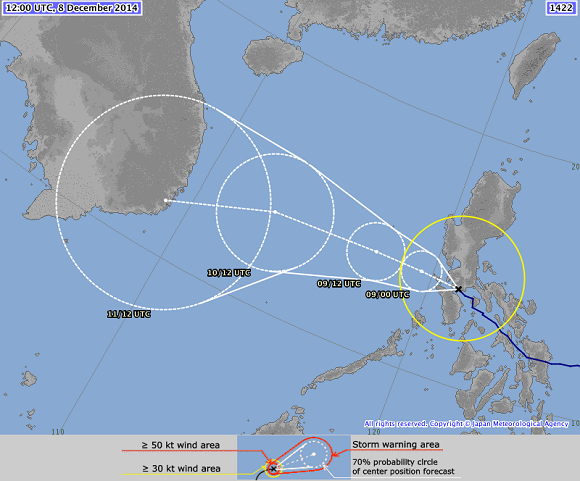Typhoon Hagupit
Status: Closed
| Type of posting | Posting date(EST): | Summary | Downloads |
|---|---|---|---|
| Landfall | 12/8/2014 12:00:00 PM |
|
|
| Pre-Landfall 1 | 12/5/2014 1:00:00 PM |
|
Landfall | Summary
Posting Date: December 8, 2014, 12:00:00 PM
Typhoon Hagupit Hits the Philippines
Typhoon Hagupit hit Eastern Samar late Saturday local time, flattening homes, toppling trees, and cutting power and communications. Wind gusts of up to 210 km/h were reported by the Philippine Atmospheric, Geophysical and Astronomical Services Administration (PAGASA). The storm was accompanied by significant precipitation. Borongan, the provincial capital of Eastern Samar, which is approximately 70 km south of the storm’s landfall location, recorded more than 400 mm of rainfall on Saturday.
Hagupit then turned north and made a second landfall in Masbate Province the next day, followed by a third landfall at tropical-storm strength on Monday night in Batangas Province. Rainfall in the 300-500 mm range has occurred over much of the Visayas and southern Luzon regions. A weather bulletin issued Monday night local time called for winds up to 100 km/h and storm surge up to 1 meter in Batangas, northern Mindoro Island, and Lubang Island. Less intense wind is expected in and around Manila, but precipitation is expected to be heavy. Because of the area's geography, many parts of Manila are susceptible to flash floods and thousands of people living near the coast and rivers have been evacuated. Soldiers and emergency workers have been put on standby to respond to any contingency.
Reported Damage
Ahead of the storm, more than 1.2 million people were evacuated into more than 1,500 schools, civic centers, town halls, gyms, and churches across the region, according to the Red Cross. Financial markets, schools, and government offices were closed on Monday. A total of 183 flights had been canceled and five airports closed, and there were power outages reported in 16 provinces.
The region around Hagupit’s initial landfall experienced the highest levels of reported damage. Around 2,500 houses were totally or partially destroyed in Borongan, a town of 64,000 people, and 21 deaths have been reported in the central Philippines.
The Philippine Secretary of Agriculture said initial reports put crop and farm infrastructure damage at PHP 1 billion (USD 22 million). Rice crops were heavily affected, with almost 100% of rice fields in the town of Dolores submerged.
The city of Tacloban, which was devastated by Typhoon Haiyan last year, has emerged relatively unscathed, with isolated roofs blown away and flooded streets.
Forecast Track and Intensity
Hagupit, known locally as Ruby, is currently a tropical storm moving west-northwest at a speed of 10 km/h. It is expected to continue this track through the next 36 hours, passing about 48 km south of Manila. The storm is then expected to impact southern Vietnam and Cambodia after it crosses the South China Sea later this week. Gradual weakening of the storm is projected during this time. Heavy precipitation is Hagupit’s major risk. Rainfall rates of 5-15 mm/h are forecast, with locally higher amounts, which have the potential to cause flooding and mudslides.
Typhoon Hagupit's location and track as of 12:00 UTC, December 8, 2014 (Source: JMA)
Exposure at Risk
The region that bore the initial brunt of Typhoon Hagupit’s impact is largely rural and agricultural. This region is generally less urbanized and less accustomed to typhoons, and the resilience of construction and construction standards are lower than those in the northern islands. While reinforced masonry structures are typical, light materials—such as wood frame with galvanized iron and aluminum roofs—are frequently used for residential buildings in rural areas, making such structures vulnerable.
Well-constructed engineered buildings could have some damage to roofing and siding, especially to windward corners, rakes, and eaves. Some apartment building and shopping center roof coverings could experience moderate levels of damage, and wall siding may also experience some moderate levels of wind damage. Structural damage is not expected for engineered structures.
Typhoon and flood damage are usually covered together in the Philippines and are offered under separate fire policies with named perils extensions. Given that insurance penetration is typically no more than 10% to 20%, insured losses are not expected to be significant as a result of this event.
This will be the final communication on Typhoon Hagupit.